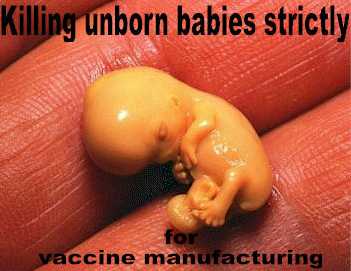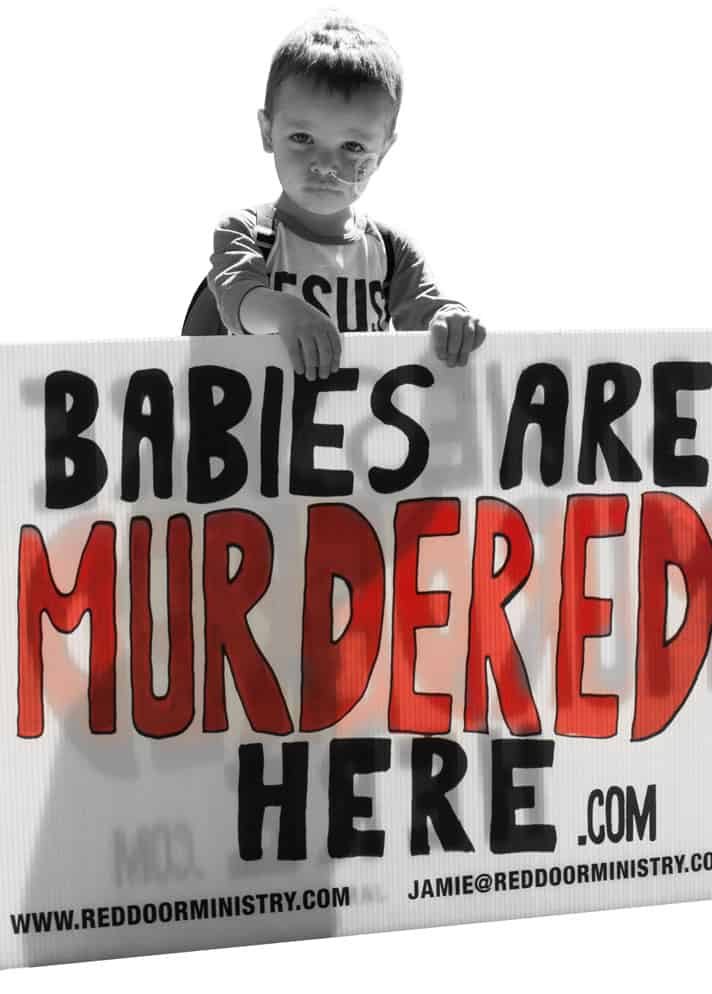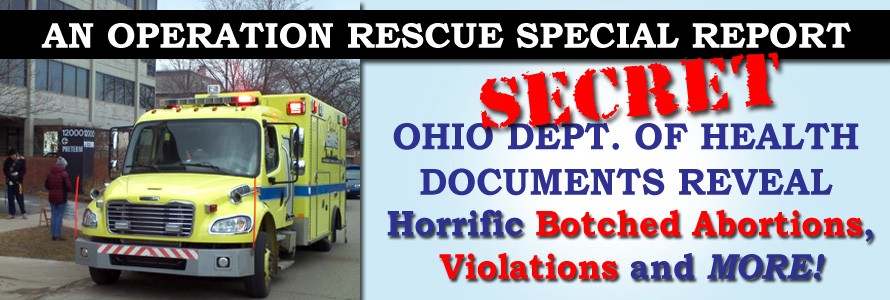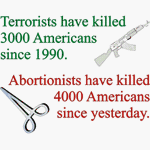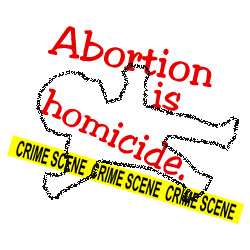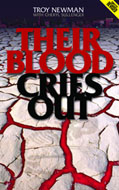 A
chain is only as strong as its weakest link, and a society is only as
strong as its treatment of its weakest members. Little precious
living children, who are too young and weak to defend themselves, are
woefully tortured―having their brains sucked out while alive, being
sizzled alive in acids, having a surgeon's hook thrust into their little
developing bodies―God is intensely angry with the world, especially
America (Psalm 7:11)!
A
chain is only as strong as its weakest link, and a society is only as
strong as its treatment of its weakest members. Little precious
living children, who are too young and weak to defend themselves, are
woefully tortured―having their brains sucked out while alive, being
sizzled alive in acids, having a surgeon's hook thrust into their little
developing bodies―God is intensely angry with the world, especially
America (Psalm 7:11)!
Is
it any wonder why Americans are suing each other more than any other
people in the world? We witness so much hatred today in the
society―in our movies, in the news, in our music, in the courtroom, even
in our churches. America's attitude towards its babies sets the
precedent for our attitude towards each other.
~David J. Stewart
Abortion Torture Methods
Surgical Abortions
There are many methods of
abortion. The procedure used depends largely upon the stage of pregnancy
and the size of the unborn child. Dr. J.C. Willke, in his book, Abortion Questions and Answers
(Hayes Publishing Co. Inc,
Cincinnati, 1985), has divided the methods of abortion into three main
categories: those that invade the uterus and kill the child by
instruments which enter the uterus through the cervix; those that kill
the preborn child by administration of drugs and then induce labour and
the delivery of a dead baby; and, those that invade the uterus by
abdominal surgery.
Dilation of the uterus is required
in cervical methods of abortion. The usual method of dilation is to
insert a series of instruments of increasing size into the cervix. A set
of dilators, metallic curved instruments, are used to open the cervix
sufficiently to accommodate the instruments of abortion. In contrast
with a normal birth, where the dilation occurs slowly over a period of
many hours, the forceful stretching by the abortionist to open the
cervix takes a matter of seconds. This premature and unnatural
stretching of the cervix can result in permanent physical injury to the
mother.
Laminaria (dehydrated material, usually
seaweed) is sometimes used to reduce damage to the cervix. Inserted into
the cervix the day before the scheduled abortion, it absorbs water and
swells, gradually pushing open the cervix in the process.
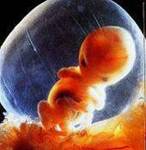 Eight-week pre-born
baby
Eight-week pre-born
baby
At eight to nine weeks the eyelids have
begun forming and hair appears. By the ninth and tenth weeks the
preborn child sucks her thumb, turns somersaults, jumps, can squint
to close out light, frown, swallow, and move her tongue.
At this early stage of
development, suction abortions are performed using a smaller tube,
requiring little dilation of the cervix. This is called "menstrual
extraction." However, if all the fetal remains are not removed,
infection results, requiring full dilation of the cervix and a
scraping out of the womb.
Suction Aspiration
 This
is the most common method of abortion during the first 12 weeks
of pregnancy. General or local anesthesia is given to the mother and her
cervix is quickly dilated. A suction curette (hollow tube with a
knife-edged tip) is inserted into the womb. This instrument is then
connected to a vacuum machine by a transparent tube. The vacuum suction,
29 times more powerful than a household
vacuum cleaner, tears the fetus and placenta into small
pieces which are sucked through the tube into a bottle and discarded.
This
is the most common method of abortion during the first 12 weeks
of pregnancy. General or local anesthesia is given to the mother and her
cervix is quickly dilated. A suction curette (hollow tube with a
knife-edged tip) is inserted into the womb. This instrument is then
connected to a vacuum machine by a transparent tube. The vacuum suction,
29 times more powerful than a household
vacuum cleaner, tears the fetus and placenta into small
pieces which are sucked through the tube into a bottle and discarded.
Dilation and Curettage (D&C)
This method is similar to the
suction method with the added insertion of a hook shaped knife (curette)
which cuts the baby into pieces. The pieces are scraped out through the
cervix and discarded [Note: This abortion method should not be confused
with a therapeutic D&C done for reasons other than pregnancy.]
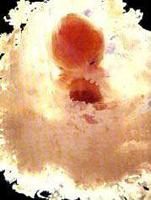 Twelve-week
pre-born baby
Twelve-week
pre-born baby
By the end of the third month all
arteries are present, including the coronary vessels of the heart.
Blood is circulating through these vessels to all body parts.
The heart beat ranges during this fetal
period from 110 to 160 beats per minute. All blood cells are
produced by the liver and spleen, a job soon taken over by the bone
marrow. White blood cells, important for immunity, are formed in the
lymph nodes and thymus.
Vocal chords are complete, and the child
can and does sometimes cry (silently). The brain is fully formed, and
the child can feel pain. The fetus may even suck his thumb. The eyelids
now cover the eyes, and will remain shut until the seventh month to
protect the delicate optical nerve fibers.
14 weeks - Muscles lengthen and
become organized. The mother will soon start feeling the first flutters
of the baby kicking and moving inside.
15 weeks - The fetus has an adult's
taste buds and may be able to savor the mother's meals.
16 weeks - Five and a half inches
tall and only six ounces in weight, eyebrows, eyelashes and fine hair
appear. The child can grasp with his hands, kick, or even somersault.

Eighteen week pre-born baby
The fetus is now about 5 inches long. The child blinks, grasps,
and moves her mouth. Hair grows on the head and body.
20 weeks - The child can hear
and recognize mother's voice. Though still small and fragile, the
baby is growing rapidly and could possibly survive if born at this
stage. Fingernails and fingerprints appear. Sex organs are visible.
Using an ultrasound device, the doctor can tell if the child is a
girl or a boy. The one on the left is a baby girl.
Dilation and Evacuation (D&E)
This method is used up to 18
weeks' gestation. Instead of the loop-shaped knife used in D&C
abortions, a pair of forceps is inserted into the womb to grasp part of
the fetus. The teeth of the forceps twist and tear the bones of the
unborn child. This process is repeated until the fetus is totally
dismembered and removed. Usually the spine must be snapped and the skull
crushed in order to remove them.
Salt Poisoning (Saline
Injection):
 Used
after 16 weeks (four months) when enough fluid has accumulated. A long
needle injects a strong salt solution through the mother's abdomen into
the baby's sac. The baby swallows this fluid and is poisoned by it. It
also acts as a corrosive, burning off the outer layer of skin. It
normally takes somewhat over an hour for the baby to die from this.
Within 24 hours, labor will usually set in and the mother will give
birth to a dead or dying baby. (There have been many cases of these
babies being born alive. They are usually left unattended to die.
However, a few have survived and later been adopted.)
Used
after 16 weeks (four months) when enough fluid has accumulated. A long
needle injects a strong salt solution through the mother's abdomen into
the baby's sac. The baby swallows this fluid and is poisoned by it. It
also acts as a corrosive, burning off the outer layer of skin. It
normally takes somewhat over an hour for the baby to die from this.
Within 24 hours, labor will usually set in and the mother will give
birth to a dead or dying baby. (There have been many cases of these
babies being born alive. They are usually left unattended to die.
However, a few have survived and later been adopted.)

Six month pre-born baby
Seen here at six months,
the unborn child is covered with a fine, downy hair
called lanugo. Its tender skin is protected by a waxy
substance called vernix. Some of this substance may
still be on the child's skin at birth at which time it
will be quickly absorbed. The child practices breathing
by inhaling amnionic fluid into developing lungs.
Prostaglandin Chemical
Abortion:
 This
form of abortion uses chemicals developed by the Upjohn Pharmaceutical
Co. which cause the uterus to contract intensely, pushing out the
developing baby. The contractions are more violent than normal, natural
contractions, so the unborn baby is frequently killed by them -- some
have even been decapitated. Many, however, have also been born alive.
This
form of abortion uses chemicals developed by the Upjohn Pharmaceutical
Co. which cause the uterus to contract intensely, pushing out the
developing baby. The contractions are more violent than normal, natural
contractions, so the unborn baby is frequently killed by them -- some
have even been decapitated. Many, however, have also been born alive.
Hysterectomy
or Caesarean Section:
Used mainly in the last three
months of pregnancy, the womb is entered by surgery through the wall of
the abdomen. The technique is similar to a Caesarean delivery, except
that the umbilical cord is usually cut while the baby is still in the
womb, thus cutting off his oxygen supply and causing him to suffocate.
Sometimes the baby is removed alive and simply left in a corner to die
of neglect or exposure.

30 weeks
- For several months, the
umbilical cord has been the baby's lifeline to the mother.
Nourishment is transferred from the mother's blood, through
the placenta, and into the umbilical cord to the fetus. If
the mother ingests any toxic substances, such as drugs or
alcohol, the baby receives these as well.
32 weeks - The fetus
sleeps 90-95% of the day, and sometimes experiences REM
sleep, an indication of dreaming.
Five steps to a partial birth
abortion:
 1)
Guided by ultrasound, the abortionist grabs the baby's legs with
forceps.
1)
Guided by ultrasound, the abortionist grabs the baby's legs with
forceps.
2) The baby's leg is
pulled out into the birth canal.
3) The abortionist
delivers the baby's entire body, except for the head.
4) The abortionist jams scissors into the baby's
skull. The scissors are then opened to enlarge the skull.

5) The scissors are removed and a suction
catheter is inserted. The child's brains are sucked out, causing the
skull to collapse. The dead baby is then removed.

40
weeks - The baby, now
approximately seven and a half pounds, is ready for life
outside its mother's womb. At birth the placenta will detach
from the side of the uterus and the umbilical cord will
cease working as the child takes his first breaths of air.
The child's breathing will trigger changes in the structure
of the heart and bypass arteries which will force all blood
to now travel through the lungs.

 Eight-week pre-born
baby
Eight-week pre-born
baby
 Twelve-week
pre-born baby
Twelve-week
pre-born baby 







